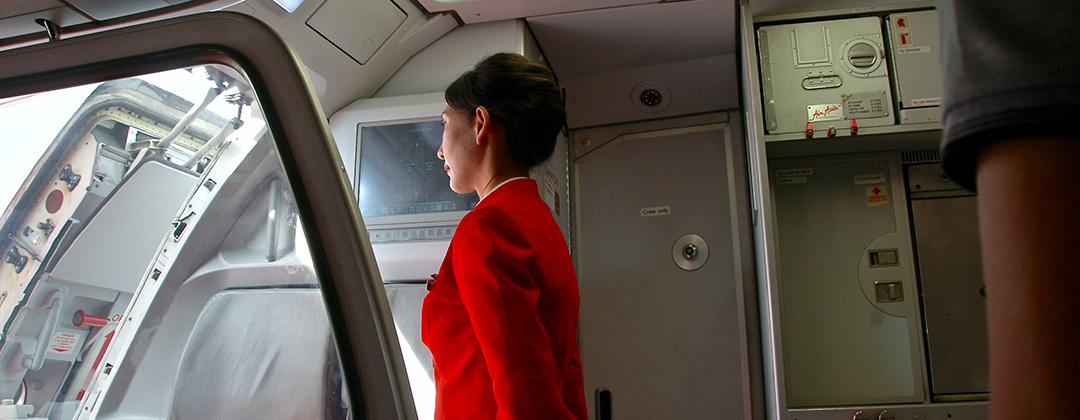When choosing your aircraft interior materials, there are a few special considerations you should take into account. Each of the following considerations are important because they contribute to the health, wellness and safety of airline passengers and crew members. They apply whether you’re choosing aircraft interior materials for business aviation, general aviation, military aircraft or VIP aircraft. Keep in mind that all materials should also follow the Federal Aviation Administration (FAA), Original Equipment Manufacturer (OEM) and Boeing regulations.
1. Noise Reduction
Aircraft necessarily create a lot of unwanted noise. The common rumble or roar heard from a plane comes from the engines and air flow, which transmits through the fuselage and overall structure. In order to make the airplane interior quieter, a combination of thermal/acoustic blankets, elastomeric isolators and other noise reduction material needs to be applied. Some materials abate sound more efficiently than others. Look for materials that can provide the necessary sound transmission loss (STL) without compromising on your weight, space and aesthetic requirements.
2. Insulation
Aircraft insulation is extremely important as it serves a variety of purposes beyond just temperature/climate control control. Airplane insulation is used to enhance acoustic, thermal, fire resistant, anti-vibration and electrical insulation properties. However, despite these various purposes, it’s still important to consider how well the material blocks thermal transfer.
At 35,000 feet, for example, the outside temperature is about -60 degrees Fahrenheit. In combination with pressurization, aircraft insulation material helps keep the cabin warm by filling the space between the interior wall and the aircraft’s fuselage. An ideal aircraft insulation material will help maintain a comfortable interior environment and also drastically reduce both noise level and vibration.
3. Fire Resistance
Fire retardant material is a must for all aircraft. Your chosen materials should provide proven flame-retardant features to minimize the potential for a fire and help prevent or slow flame spreads if a fire were to occur, helping to ensure the safety of passengers and crew members. In fact, most aircraft interior materials are required by the FAA to be self-extinguishing.
4. Durability
While passenger safety is the most important aspect when choosing aircraft interior materials, it’s also important to have a durable product that lowers overall replacement costs.
When choosing textile materials in particular, consider two factors: fiber blend and fabric construction.
Fiber blends that utilize durable fibers, like aramids or nylon, give fabric excellent resistance to abrasions and provide long-lasting durability. These types of blends also have a much higher tear strength. Fabric construction also heavily affects the durability of aircraft interior materials. The weave, weft, weight and thread count all work together to make up a fabric’s overall durability.
5. Cleanability
An airplane is a confined space transporting people 24 hours a day. To prevent stains, bacteria growth, mildew and odors, choose aircraft interior materials that contain antimicrobial characteristics and are extremely easy to clean. This is especially important for flooring, for example.
Consider a non-textile, non-woven aircraft flooring solution for maximum cleanability. If you prefer a woven option, look for a high performance flooring product that is engineered to be resistant to water, most oils, chemicals, grease and even mildew. Also consider a non-absorbent underlay.
6. Static Resistance
Without anti-static measures in place, electrostatic charge can accumulate during a flight on both the outer and inner surfaces of the aircraft. This should be prevented in order to avoid disruptions in flight communications, refueling operations and even potential explosions in fuel areas.
The aircraft industry has adopted a few methods to minimize or eliminate this electrostatic charge accumulation, but the most common is the technique of using static dissipative materials.
7. Non-Slip Surface
Slips, trips and falls are some of the leading causes of workplace injuries, and this goes for aircraft as well. In fact, the interior of an airplane can create quite a few potentially hazardous scenarios for both employees and passengers:
- Falling during turbulence
- Slipping on a particularly slick or slippery cabin floor; like in the galley area or near the aircraft doors where contamination can be carried in from the outside
- Stumbling on stairwells between decks or from exits
For these reasons and more, non-slip aircraft flooring is important. Fortunately, you can get this benefit without compromising on other factors. You can find both textile and non textile flooring that was engineered to enhance both safety and appearance.
Get Performance Aircraft Interior Materials From Duracote
Browse Duracote’s full line of high-performing materials engineered specifically for aircraft interiors. Our flexible materials include laminated films, foams, non-woven fabrics and more with specialized coatings and constructions. If you dream it, we’ll develop it. Have a question or need more information? Feel free to reach out to our customer service team today.

